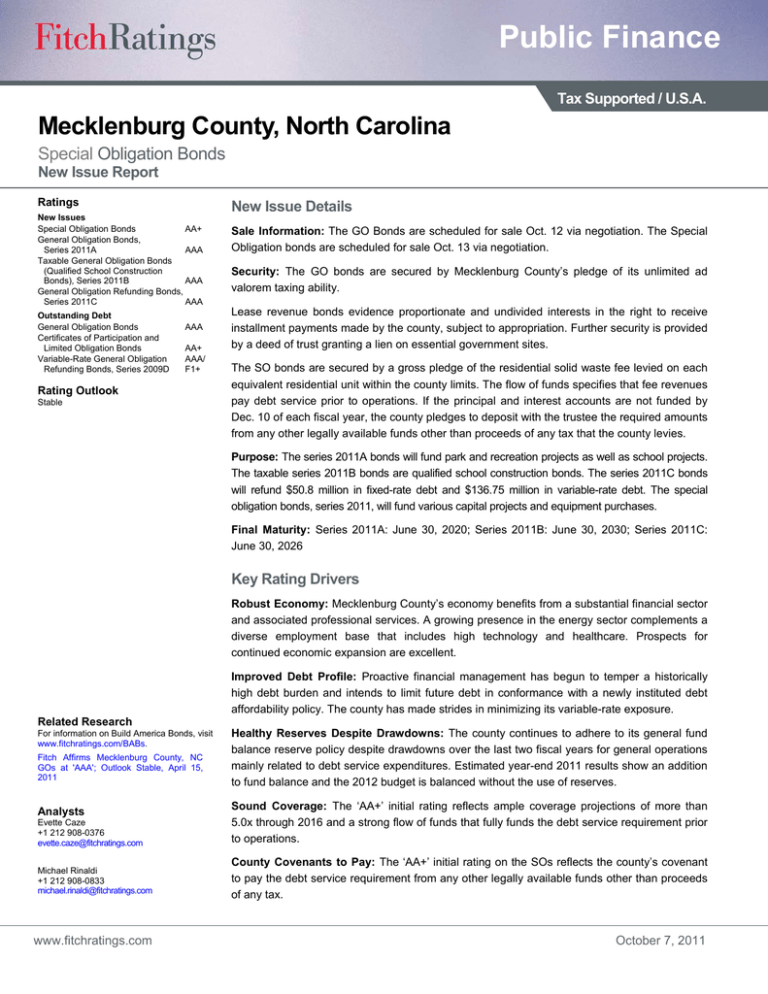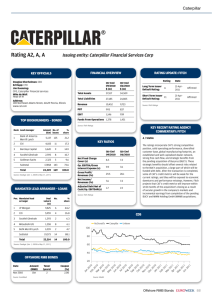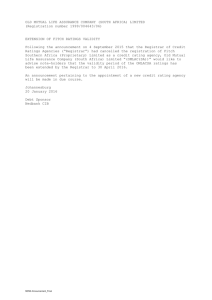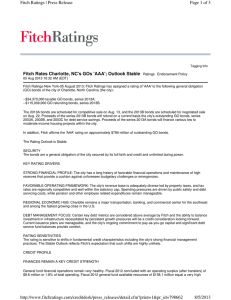Public Finance Mecklenburg County, North Carolina Special
advertisement

Public Finance Tax Supported / U.S.A. Mecklenburg County, North Carolina Special Obligation Bonds New Issue Report Ratings New Issues Special Obligation Bonds AA+ General Obligation Bonds, Series 2011A AAA Taxable General Obligation Bonds (Qualified School Construction AAA Bonds), Series 2011B General Obligation Refunding Bonds, Series 2011C AAA Outstanding Debt General Obligation Bonds Certificates of Participation and Limited Obligation Bonds Variable-Rate General Obligation Refunding Bonds, Series 2009D AAA AA+ AAA/ F1+ Rating Outlook Stable New Issue Details Sale Information: The GO Bonds are scheduled for sale Oct. 12 via negotiation. The Special Obligation bonds are scheduled for sale Oct. 13 via negotiation. Security: The GO bonds are secured by Mecklenburg County’s pledge of its unlimited ad valorem taxing ability. Lease revenue bonds evidence proportionate and undivided interests in the right to receive installment payments made by the county, subject to appropriation. Further security is provided by a deed of trust granting a lien on essential government sites. The SO bonds are secured by a gross pledge of the residential solid waste fee levied on each equivalent residential unit within the county limits. The flow of funds specifies that fee revenues pay debt service prior to operations. If the principal and interest accounts are not funded by Dec. 10 of each fiscal year, the county pledges to deposit with the trustee the required amounts from any other legally available funds other than proceeds of any tax that the county levies. Purpose: The series 2011A bonds will fund park and recreation projects as well as school projects. The taxable series 2011B bonds are qualified school construction bonds. The series 2011C bonds will refund $50.8 million in fixed-rate debt and $136.75 million in variable-rate debt. The special obligation bonds, series 2011, will fund various capital projects and equipment purchases. Final Maturity: Series 2011A: June 30, 2020; Series 2011B: June 30, 2030; Series 2011C: June 30, 2026 Key Rating Drivers Robust Economy: Mecklenburg County’s economy benefits from a substantial financial sector and associated professional services. A growing presence in the energy sector complements a diverse employment base that includes high technology and healthcare. Prospects for continued economic expansion are excellent. Improved Debt Profile: Proactive financial management has begun to temper a historically high debt burden and intends to limit future debt in conformance with a newly instituted debt affordability policy. The county has made strides in minimizing its variable-rate exposure. Related Research For information on Build America Bonds, visit www.fitchratings.com/BABs. Fitch Affirms Mecklenburg County, NC GOs at 'AAA'; Outlook Stable, April 15, 2011 Analysts Evette Caze +1 212 908-0376 evette.caze@fitchratings.com Healthy Reserves Despite Drawdowns: The county continues to adhere to its general fund balance reserve policy despite drawdowns over the last two fiscal years for general operations mainly related to debt service expenditures. Estimated year-end 2011 results show an addition to fund balance and the 2012 budget is balanced without the use of reserves. Sound Coverage: The ‘AA+’ initial rating reflects ample coverage projections of more than 5.0x through 2016 and a strong flow of funds that fully funds the debt service requirement prior to operations. Michael Rinaldi +1 212 908-0833 michael.rinaldi@fitchratings.com County Covenants to Pay: The ‘AA+’ initial rating on the SOs reflects the county’s covenant to pay the debt service requirement from any other legally available funds other than proceeds of any tax. www.fitchratings.com October 7, 2011 Public Finance Rating History Special Obligation Bonds Rating AA+ Action Assigned Outlook/ Watch Stable Additional Key Drivers Date 10/3/11 Rating History General Obligation Bonds Rating AAA AAA AAA AAA AAA AAA AAA AAA AAA AAA AAA AAA AAA AAA AAA AAA AAA AAA AAA AAA Outlook/ Watch Stable Stable Stable Stable Stable Stable Stable Stable Stable Stable Stable Stable Stable Stable Stable Stable Stable Stable Stable Action Affirmed Affirmed Affirmed Affirmed Affirmed Affirmed Affirmed Affirmed Affirmed Affirmed Affirmed Affirmed Affirmed Affirmed Affirmed Affirmed Affirmed Affirmed Affirmed Assigned Appropriation Lien on Essential Assets: Lease revenue bonds contain solid legal provisions. Installment payments are subject to appropriation, and there is a lien on essential government assets. Ample Liquidity: The short-term ‘F1+’ rating reflects the sufficiency of county liquid resources to fund any unremarketed puts on its debt. In addition, the county’s long-term credit rating of ‘AAA’ implies access to the capital markets in the event of a remarketing failure. Credit Profile Date 10/3/11 4/15/11 2/12/10 10/30/09 7/28/09 7/14/09 2/5/09 1/13/09 12/18/08 2/13/08 1/3/08 1/4/07 1/27/06 3/8/05 1/6/05 3/31/04 2/3/04 1/7/04 1/16/03 1/6/00 Debt The county has historically exhibited overall debt ratios that have been high for the ‘AAA’ rating category. Fitch views the county’s 2008 revised debt policies as liberal although the county explicitly states no intention of nearing the policy limits. Direct debt ratios are well within policy guidelines, which restrict debt to assessed value to 4% and debt per capita to $4,200. Overall debt levels, which include the debt of overlapping municipalities, are inconsistent with such Debt Statistics a highly rated credit at $4,581 per capita ($000) New Money 100,000 and 4.2% of market value. Outstanding Direct Debt Net of Refunding 1,931,648 Debt amortization is above average at Self-Supporting 13,082 2,018,566 about 69% retiring in 10 years, in Total Net Direct Debt 2,194,068 compliance with county policy of 64%. Overlapping Debt Total Overall Debt 4,212,634 The county has reduced its variableDebt Ratios rate debt exposure from a high of 45% Net Direct Debt Per Capita ($)a 2,195 to a manageable 22% in just three As % of Market Valueb 2.0 years. The county’s unhedged Overall Debt Per Capita ($)a 4,581 b 4.2 variable-rate exposure is currently at As % of Market Value a b 8% of total debt. The county’s debt Population: 919,628 (2010). Market value: $100,325,830,000 (fiscal 2010). Note: Numbers may not add due to rounding. guidelines permit unhedged variablerate debt exposure to reach 35% of total debt and did not limit synthetically fixed-rate debt, which Fitch views with concern. Somewhat offsetting Fitch’s concerns on debt are the limited long-term obligations associated with pensions and other post-employment benefits (OPEBs). As part of a restructured capital planning process, the county instituted more stringent debt affordability guidelines. It intends to restrict future capital projects to those that can be financed within the calculated debt capacity and available pay-as-you-go capital funds. Related Criteria U.S Local Government Tax-Supported Rating Criteria, Aug. 15, 2011 Tax-Supported Aug. 15, 2011 Rating Criteria, Mecklenburg County, North Carolina October 7, 2011 Debt issued within policy parameters will result in debt service payments equal to between 17% and 19.7% of the budget over the next five years. Although Fitch views this percentage as high, it notes that it is consistent with historical levels, which have not in the past hampered financial flexibility. Adherence to the metric has resulted in the elimination of fiscal 2011 debt issuances and thereafter a proposed $100 million debt issuance annually or a lower amount consistent with the debt service fund model. The county is committed to annual pay-as-you-go financing amounts equal to three cents of the tax rate and a portion of excess fund balance. 2 Public Finance Covenant to Fund SOs While bondholders benefit from strong coverage from gross revenues collected on the property tax bill, the ‘AA+’ rating solely reflects the county’s covenant to fund debt service payments. Within 10 days after the end of each month, the county will deposit with the trustee gross solid waste fee revenues into the interest account, an amount equal to the interest payable on the bonds on the next two interest payment dates, and into the principal account, an amount equal to the principal due on the next Jan. 1. The county’s obligation to make such deposits shall cease for each fiscal year when the principal and interest accounts have been funded as described above. If the principal and interest accounts are not funded as described above by Dec. 10 of each fiscal year, the county covenants that by that date it will cause to be deposited with the trustee the required amounts from any other legally available funds other than proceeds of any tax that the county levies. Finances General Fund Financial Summary ($000, Audited Fiscal Years Ended June 30) 2006 2007 2008 2009 2010 Property Tax 726,716 735,633 786,211 815,224 836,066 Sales Tax 182,786 206,254 208,930 166,021 153,107 Other Tax 6,946 6,893 6,991 7,110 7,651 916,448 948,780 1,002,132 988,355 996,824 Total Tax Revenue License and Permits 25,436 26,668 23,770 14,896 12,440 Charges for Services 84,861 80,433 78,777 66,664 63,381 153,857 170,909 193,120 202,165 193,977 28,241 37,218 35,329 23,221 10,868 1,208,843 1,264,008 1,333,128 1,295,301 1,277,490 Intergovernmental Other General Fund Revenue Health and Social Services 301,586 293,424 315,307 310,978 304,144 Debt Service 204,662 222,552 233,287 247,319 257,648 Other 612,343 672,841 734,071 747,881 696,853 General Fund Expenditures 1,118,591 1,188,817 1,282,665 1,306,178 1,258,645 General Fund Surplus/(Loss) 18,845 90,252 75,191 50,463 (10,877) Transfers In 0 0 508 19,679 1,815 Other Sources 0 6,307 13,283 285,459 648,018 38,993 29,584 45,578 37,789 60,568 0 0 0 276,842 638,142 Transfers Out Other Uses Other Net Adjustments Net Transfers and Other 0 0 0 0 0 (38,993) (23,277) (31,787) (9,493) (48,877) Net Surplus/(Deficit) 51,259 51,914 18,676 (20,370) (30,032) Total Fund Balance 291,555 343,468 362,144 359,549 329,469 25.2 28.2 27.3 22.2 16.8 194,233 244,382 265,285 260,840 220,980 16.8 20.1 20.0 16.1 11.3 As % of Expenditures, Transfers Out, and Other Uses Unreserved Fund Balance As % of Expenditures, Transfers Out, and Other Uses Note: Numbers may not add due to rounding. Reserve levels remain sound, despite recent revenue softening, as the county implemented expenditure reductions to manage its growth-related financial needs within the constraints of its budget. Fiscal 2010 concluded with a general fund drawdown of $30 million from a $1.3 billion Mecklenburg County, North Carolina October 7, 2011 3 Public Finance budget, after more than $50 million of transfers out for pay-as-you-go capital financing and capital reserve funding. The unreserved fund balance remained solid at 16.8% of fiscal 2010 spending, partially offsetting the high debt service costs, which reached 18.4% of total general government spending. When factoring state required fund balance reservations for certain receivables, which Fitch considers as available, reserves equaled 23% of spending, above the county’s 12%–14% fund balance target. The fiscal 2011 budget reduced expenditures to fiscal 2007 levels, and the county anticipates ending the current year with a general fund surplus, bringing the estimated unreserved fund balance to approximately $264 million, or 19% of fiscal 2011 spending. The fiscal 2012 general fund budget totals $1.3 billion, an increase of 2.7% over the fiscal 2011 level, and is the first budget in 10 years that does not appropriate fund balance. Fitch believes that, ultimately, the willingness to reduce expenditures and the commitment to structural balance will further strengthen the county’s financial profile. Economy Mecklenburg County’s robust economy provides consistent credit strength, buttressed by financial and professional services that are supplemented by a growing presence in energy production, tourism, high-technology manufacturing, and health and education. Anchored by the city of Charlotte, with a transportation infrastructure supported by Charlotte-Douglas International Airport (revenue bonds rated ‘A+’ with a Stable Rating Outlook by Fitch), the diverse economy contains the second largest financial center in the U.S. and more than 274 of the Fortune 500 companies. Duke Energy and Progress Energy have proposed a merger to create the largest electric utility in the county, to be headquartered in Charlotte, attesting to the region’s increasing attractiveness to the Mecklenburg County, North Carolina energy sector. The city’s light rail system is expected to spur further Raleigh development. The strong employment Area of Detail base has helped fuel the county’s rapid population growth to 919,628, representing a 3.5% Mecklenburg average annual increase County since the last census, well above the nationwide 1% average annual growth Charlotte during that period. Wealth levels are above state and 74 national averages. The July 2011 unemployment rate of 11.1% declined slightly from the 11.3% of the previous year but remained above the state and national rates of 10.3% and 9.3%, respectively, due to stagnant labor force and employment activity. Mecklenburg County, North Carolina October 7, 2011 4 Public Finance The ratings above were solicited by, or on behalf of, the issuer, and therefore, Fitch has been compensated for the provision of the ratings. ALL FITCH CREDIT RATINGS ARE SUBJECT TO CERTAIN LIMITATIONS AND DISCLAIMERS. PLEASE READ THESE LIMITATIONS AND DISCLAIMERS BY FOLLOWING THIS LINK: HTTP://FITCHRATINGS.COM/UNDERSTANDINGCREDITRATINGS. IN ADDITION, RATING DEFINITIONS AND THE TERMS OF USE OF SUCH RATINGS ARE AVAILABLE ON THE AGENCY'S PUBLIC WEB SITE AT WWW.FITCHRATINGS.COM. PUBLISHED RATINGS, CRITERIA, AND METHODOLOGIES ARE AVAILABLE FROM THIS SITE AT ALL TIMES. FITCH'S CODE OF CONDUCT, CONFIDENTIALITY, CONFLICTS OF INTEREST, AFFILIATE FIREWALL, COMPLIANCE, AND OTHER RELEVANT POLICIES AND PROCEDURES ARE ALSO AVAILABLE FROM THE CODE OF CONDUCT SECTION OF THIS SITE. Copyright © 2011 by Fitch, Inc., Fitch Ratings Ltd. and its subsidiaries. One State Street Plaza, NY, NY 10004.Telephone: 1-800-753-4824, (212) 908-0500. Fax: (212) 480-4435. Reproduction or retransmission in whole or in part is prohibited except by permission. All rights reserved. In issuing and maintaining its ratings, Fitch relies on factual information it receives from issuers and underwriters and from other sources Fitch believes to be credible. Fitch conducts a reasonable investigation of the factual information relied upon by it in accordance with its ratings methodology, and obtains reasonable verification of that information from independent sources, to the extent such sources are available for a given security or in a given jurisdiction. The manner of Fitch’s factual investigation and the scope of the third-party verification it obtains will vary depending on the nature of the rated security and its issuer, the requirements and practices in the jurisdiction in which the rated security is offered and sold and/or the issuer is located, the availability and nature of relevant public information, access to the management of the issuer and its advisers, the availability of pre-existing third-party verifications such as audit reports, agreed-upon procedures letters, appraisals, actuarial reports, engineering reports, legal opinions and other reports provided by third parties, the availability of independent and competent third-party verification sources with respect to the particular security or in the particular jurisdiction of the issuer, and a variety of other factors. Users of Fitch’s ratings should understand that neither an enhanced factual investigation nor any third-party verification can ensure that all of the information Fitch relies on in connection with a rating will be accurate and complete. Ultimately, the issuer and its advisers are responsible for the accuracy of the information they provide to Fitch and to the market in offering documents and other reports. In issuing its ratings Fitch must rely on the work of experts, including independent auditors with respect to financial statements and attorneys with respect to legal and tax matters. Further, ratings are inherently forward-looking and embody assumptions and predictions about future events that by their nature cannot be verified as facts. As a result, despite any verification of current facts, ratings can be affected by future events or conditions that were not anticipated at the time a rating was issued or affirmed. The information in this report is provided “as is” without any representation or warranty of any kind. A Fitch rating is an opinion as to the creditworthiness of a security. This opinion is based on established criteria and methodologies that Fitch is continuously evaluating and updating. Therefore, ratings are the collective work product of Fitch and no individual, or group of individuals, is solely responsible for a rating. The rating does not address the risk of loss due to risks other than credit risk, unless such risk is specifically mentioned. Fitch is not engaged in the offer or sale of any security. All Fitch reports have shared authorship. Individuals identified in a Fitch report were involved in, but are not solely responsible for, the opinions stated therein. The individuals are named for contact purposes only. A report providing a Fitch rating is neither a prospectus nor a substitute for the information assembled, verified and presented to investors by the issuer and its agents in connection with the sale of the securities. Ratings may be changed or withdrawn at anytime for any reason in the sole discretion of Fitch. Fitch does not provide investment advice of any sort. Ratings are not a recommendation to buy, sell, or hold any security. Ratings do not comment on the adequacy of market price, the suitability of any security for a particular investor, or the tax-exempt nature or taxability of payments made in respect to any security. Fitch receives fees from issuers, insurers, guarantors, other obligors, and underwriters for rating securities. Such fees generally vary from US$1,000 to US$750,000 (or the applicable currency equivalent) per issue. In certain cases, Fitch will rate all or a number of issues issued by a particular issuer, or insured or guaranteed by a particular insurer or guarantor, for a single annual fee. Such fees are expected to vary from US$10,000 to US$1,500,000 (or the applicable currency equivalent). The assignment, publication, or dissemination of a rating by Fitch shall not constitute a consent by Fitch to use its name as an expert in connection with any registration statement filed under the United States securities laws, the Financial Services and Markets Act of 2000 of Great Britain, or the securities laws of any particular jurisdiction. Due to the relative efficiency of electronic publishing and distribution, Fitch research may be available to electronic subscribers up to three days earlier than to print subscribers. Mecklenburg County, North Carolina October 7, 2011 5







